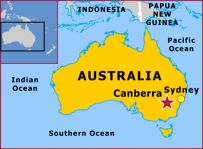 Australia Overview
Australia Overview
Australia has come a long way since the days when Captain Cook stumbled ashore to find an aboriginal way of life that went back for tens of thousands of years. Even the outdated images of Crocodile Dundee types swilling beer around the Opera House have long been replaced by a forward-looking attitude that embraces Australia’s Pacific Rim location and a growing reputation for first-class cuisine and high fashion notable in its cosmopolitan, twenty-first century metropolis, Sydney. The high quality of life in the country’s effervescent largest city is enhanced by one of the world’s great harbors, but there is far more to Australia city-wise than just Sydney. Its big rival, Melbourne, is blessed with a more European ambiance, with trams and pavement cafes as much a part of the experience as the buzzing sports and cultural scene, while coastal Darwin, Perth and Brisbane offer other worlds to explore. Away from the cities, Australia’s stunningly diverse landscape boasts everything from vast, barren deserts to tropical rainforests, rugged mountains and pristine beaches, such as world-class Bondi, Cable Beach and Whitehaven. Then, of course, there’s the epic monolith of Uluru (Ayers Rock) and the Great Barrier Reef, where another undiscovered world opens up beneath the surf.
General Information
Area: 7,692,300 sq km (2,969,909 sq miles)
Population: 19,546,792
Capital: Canberra
Geography: Australia is bounded by the Arafura Sea and Timor Seas to the north, the Coral and Tasman Seas of the South Pacific to the east, the Southern Ocean to the south, and the Indian Ocean to the west. Its coastline covers 36,738km (22,814 Miles). Australia is the smallest continent (or the largest island) in the world. About 40% of the continent is within the tropics and Australia is almost the same size as mainland USA.
Language: The official language is English.
Money
Currency: Australian Dollar (A$)
Credit Cards: Major credit cards are accepted. Use may be restricted in small towns and outback areas.
Banking Hours: 9:30am-4pm Monday to Thursday, 9:30am-5pm Friday.
International Travel
Air: The national airline is Qantas 9QF). 30+ international airlines fly to Australia
Approximate flight times:
London to to Brisbane 23 hours 25 minutes, Cairns 25 hours 45 minutes
Darwin 21 hours 25 minutes, Melbourne 23 hours, Sydney 23 hours 30 minutes
New York to Sydney is 20 hours
Los Angeles to Sydney is 13 hours 30 minutes
Singapore to Sydney is 8 hours
International Airports
Sydney Airport (SYD) (Kingsford Smith) (www.sydneyairport.com) is 10km (6 miles) south of the city (travel time 15 minutes).
Adelaide Airport (ADL) (wwwaal.com.au) is 7km (4 miles) west of the city (travel 15 minutes).
Perth Airport (PER) (www.perthairport.com) is 12km (7 miles) northeast of the city (travel time 25 minutes). Separate international, domestic terminals.
Brisbane Airport (BNE) (www.bne.com.au) is 13km (8 miles) NE of the city (travel 35 minutes).
Cairns Airport (CNS) (Queensland) is 8km (5 miles) from the city (travel time 10 minutes).
Social & Business Customs
Food
There are numerous specialty dishes and foods including Sydney rock oysters, barramundi (freshwater fish), tiger prawns, macadamia nuts and yabbies (small freshwater lobsters). Beef is the most popular meat and lamb is also of a high quality. There is a wide variety of excellent fruits and vegetables. Service is European-style and varies from waitress and waiter service to self-service. Bistros, Cafés, family-style restaurants and ‘pub’ lunches at the counter offer good food at reasonable prices. Some restaurants will allow guests to bring their own alcohol and are called ‘BYO’ restaurants. A country of immigrants, Australia also offers an enormous variety of international cuisine.
Drink
The major vineyards are outside Perth, Sydney, Melbourne, Hobart, Canberra and Adelaide. The largest single wine-growing region is in the Barossa Valley, South Australia, where high-quality red and white wines are produced. Australian wines are good and inexpensive. Beer is served chilled.
Shopping
Special purchases include excellent local wines; wool, clothing, leather and sheepskin products; opal and other precious or semi-precious stones; and modern art sculpture and paintings. Exhibitions of bark painting,s boomerangs and other tribal objects are on view an dsale in Dawin, Alice Springs and State capitals.
Shopping Hours
Most stores in cities are open 9am-5:30pm Monday to Friday and 9am-5pm Saturday. Shops are open all day Saturday in S. Australia and W. Australia.
Social
A largely informal atmosphere prevails; shaking hands is the customary greeting. Casual wear is worn everywhere except in the most exclusive restaurants, social gatherings and business meetings.
Tipping
Not as common as it is in Europe and America nor is a service charge added to the bill in restaurants. 10% for food and drink waiters is usual in top-quality restaurants, but is optional elsewhere. With taxis, it is not usual to tip but round up to the next dollar.
Business
Suits are necessary in Sydney and Melbourne. Brisbane business people may wear shirts, ties and shorts; visiting business people should wear lightweight suits for the initial meeting. Prior appointments necessary. Punctuality is important. A great dal of business is conducted over drinks. Best months for business travel are March to November. Office hours: Mon-Fri 9am-5pm.
Climate
Australia is in the Southern Hemisphere and the seasons are opposite to those in Europe and North America. There are two climatic zones: the tropical zone in the north above the Tropic of Capricorn and the Temperate Zone. The tropical zone which consists 40% of Australia has two seasons, summer (‘wet’) and winter (‘dry’) while the temperate zone has all four season. From Novemeber-March (spring-summer), it is warm or hot everywhere, tropical in the north, and warm to hot with mild nights in the south. From April-September (autumn-winter), northern and central Australia have clear warm days and cool nights while the south has cool days with occasional rain but still plenty of sun. Snow is confined to mountainous regions or the southeast.